(9724 products available)
































































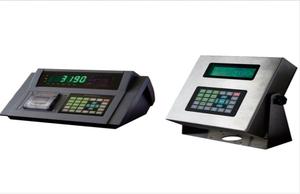































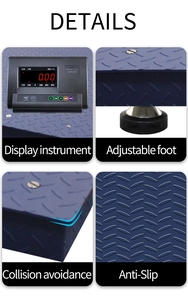





























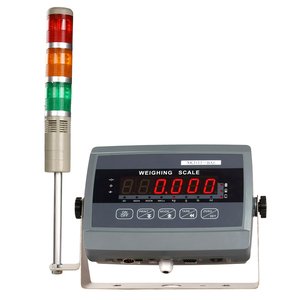






















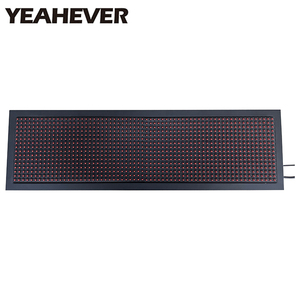

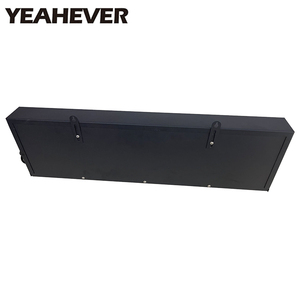
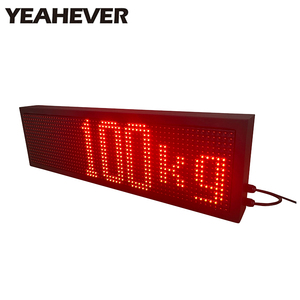
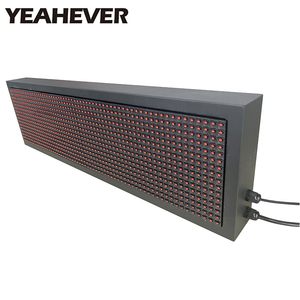




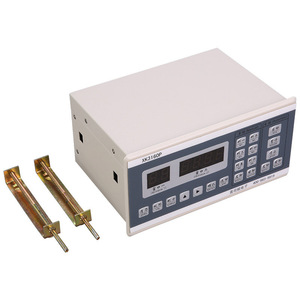

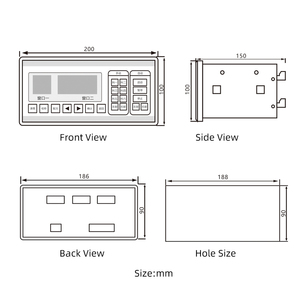










































Weighing indicators operate using various types of load cells. Also called load cell displays or load cell monitors, they convert weight measurements into electronic signals.
The following are five common kinds of industrial digital scale indicator:
This is the most widely used type in the indication of weights. The strain gauge works by attaching metal foils in a patterned shape to the load cell. When an object exerts weight on the load cell, the cell deforms slightly. This deformation causes minute changes in the electric resistance of the foil, which strain gauge measures. These are commonly used on bench scales.
Instead of using electric signals, these load cells measure pressure. The cells contain fluid inside their sealed metal boxes. Placing weight on the box compresses the fluid. This causes it to exert pressure, which the cell quantifies. The pressure is converted to the correct weight. These types of cells are ideal for weighing large equipment that does not have unstable readings.
These cells use crystal materials to measure weight. When weight gets applied, these crystals compress. This generates electric charges that correspond to the weight amount. These cells work great for dynamic weighing or fast-moving objects. For example, they are ideal for checking the weight of bags during filling in factories.
This utilizes a system of levers and fulcrums to indicate weight. They do not need electricity or batteries. The user places an object on one side while an adjustable counterweight on the other. The balanced levers then show the correct weight amount. These balances suit areas where power sources are inaccessible. For example, they check weights in remote fields or small labs.
These cells measure weight using electric capacitance. They consist of metal plates separated by thin insulation. Weight compresses the plates, changing their distance. This alters the capacitance, which gets converted to weight. These are great for providing high-precision measurements. These load cells are especially useful in pharmaceutical or chemical manufacturing. They provide accuracy in weight measurements of sensitive materials.
Industrial digital weight gauge indicators must be durable. They also need resistant properties to the harsh conditions commonly present in industrial applications. These factors ensure they provide reliable measurements over long periods in extreme environments.
These are the structures that contain the internal components of the weighing indicator. This includes the protective casings that shield the indicator from damage. Common materials used include:
These are essential parts that affect usability and withstand regular handling and environmental factors. They include:
These are the parts that make the weighing indicator function. They include the internal components like sensors, circuits, and connections. For example, they need to be housed in a durable material. Common durable materials used include:
Digital balance indicators are vital for cost savings, efficiency gains, and precision in multiple settings. Below are several common uses in which these instruments hold considerable commercial value:
People use weighing indicators in factories when checking weights for producing goods like cars and electronics. They also work well for large products that require accuracy when storing or transporting them. Digital indicators improve precision in these operations. This leads to fewer mistakes and less need for redoing work.
In restaurants and food factories, they use the indicators to get accurate weights of ingredients and finished food items. This practice helps ensure that recipes stay the same and that food remains fresh. It also helps avoid waste by ensuring people use the correct amounts of ingredients. Their use leads to cost savings and better quality control, making them essential in this industry.
Logistics managers rely on the weighing indicators to measure packages and loads precisely. This practice optimizes space in transportation, reduces costs, and meets regulations. These digital indicators also enhance accuracy regarding shipping costs and load limits. This efficiency leads to lower operational costs and fewer fines for exceeding weight limits.
Farmers use these types of indicators to measure crops, feed, and fertilizer loads precisely. They help handle bulk products like grains and ensure farmers transport the right amounts of goods. They also improve efficiency in using resources like feed and fertilizers. This saving leads to reduced labor needs and better monitoring of inputs and yields.
In this setting, people use the indicators for accurate measurements of drugs and chemicals. This accuracy ensures product safety and effectiveness complies with strict regulations in this industry. It also minimizes waste by ensuring precise formulation and usage of expensive materials. This reduction leads to significant cost savings and risk mitigation.
Be sure to find weight handling indicators in construction sites measuring materials like concrete, steel, and heavy loads. They ensure safety by preventing overloading of equipment and helping manage material usage. They also improve efficiency in supply management, minimizing waste and project delays. This benefit leads to lower costs and enhances compliance with safety regulations.
Shops use them to balance food like meat, fruit, and cheese so customers pay the right amount. Digital scales make sure customers pay fairly and reduce waste by giving correct portion sizes. It also helps shops keep costs down by not over- or under-supplying goods. Their efficiency leads to fewer returns and more satisfied customers.
Selecting the right digital weight indicators involves several key considerations. Below are some strategies to help buyers make informed decisions:
How effectively a scale performs its job depends on its ability to handle weight capacity. It is crucial to pick an indicator that matches the weight the business will weigh. For example, small food items need a smaller capacity. However, large machine parts need a much larger capacity.
If the capacity is too low, the scale will not give accurate readings. This will result in overloads that will damage the equipment. On the other hand, when the capacity is too high, it will result in wastage of resources.
Many industries have special rules about weighing. Some examples of these industries are pharmaceuticals, food processing, and chemical storage. It is crucial to consider these rules when choosing an indicator. Do not be so fast to settle for an option without checking its adherence to standards. Look for indicators that fulfill pertinent regulations in these industries.
These include FDA and NTEP certifications. Certifications ensure accuracy and safety for operations that have to follow the rules. They also lessen the chances of fines and shutdowns due to violating weight rules.
Digital balance indicators come with various display types. These vary in readability, environment suitability, and visual clarity. There are LCDs that are suitable for indoors. They are energy efficient and widely used. There are also LED displays that are suitable for indoor and outdoor use.
These displays provide better clarity in bright environments. There are backlit displays that provide readability in poorly lit environments. Users should consider the working environment and lighting conditions before selecting a display type. This selection ensures optimal readability in all conditions.
Some digital indicators require workers to read and record results, while others do the job automatically. Some indicators also come with data output. This feature helps users save time and cut costs. Businesses with many weighing tasks should consider automated indicators. These indicators reduce labor needs and errors.
It also provides faster results to increase productivity. On the flip side, small businesses with low weighing needs can opt for manual models. These models are simple to use and more affordable.
In this factor, users will consider whether their workstation is outdoors or dusty and the temperature. Harsh environments can damage digital indicators. Look for ones that have weatherproof rating enclosures. The enclosures should protect against dust and moisture.
They should also have shock and vibration resistance to ensure the instrument's integrity. Additionally, high-temperature environments may require indicators with heat-resistant components. This requirement ensures the equipment works correctly.
Clearly placed load cells help distribute weight evenly across the indicator. This balance allows the instrument to give correct readings with no sway. Placing the item in the center of the scale ensures it balances well, leading to precise measurements. Also, putting heavy items slowly on the scale prevents jolts, which can alter the reading.
People who use these indicators in harsh areas face big problems. Bad weather, dust, or chemicals can harm the gauge. Water, for example, can cause short circuits or rust on the parts. The same goes for dust and other particles, which can jam or damage the inner works.
Chemical spills, such as acids, can eat away at sensitive parts. This damage will then lead to wrong readings or even total failure. They may also damage the screens or keypads, making it hard for users to operate the equipment efficiently.
Maintaining these indicators begins with keeping them clean. Workers regularly wipe down the equipment to remove dust, grime, and residue. This practice helps prevent damage and ensures the internal parts last longer. They also check for signs of rust or corrosion on load cells and other metal parts.
This task helps them catch issues early before they affect performance. They inspect wires and connections for damage, too. Regular calibration guarantees correct readings, while software updates keep the system efficient.
Many digital balance indicators are designed for outdoor or rough conditions. They have protective housings called enclosures that keep water and dust out. These enclosures follow standards like IP65 or IP67, which shield the indicator from moisture and particles.
Some digital balances also have covers or shields that protect them from rain, snow, or dirt. Even when using one in a dusty place, users can easily clean it to ensure it stays in good order. These protective elements keep the indicator working properly for a long time.
Load cells and indicators work together to give exact weight readings. Adding anti-vibration mats helps the load cells stay still, so they give correct numbers. Placing the load cells on a flat surface keeps them even, which also boosts accuracy.
Using a windbreak around them keeps strong gusts from changing the readings. Regular checks for damage and updates to the software ensure the system works well. These steps help users get precise weights even in tough outdoor conditions.